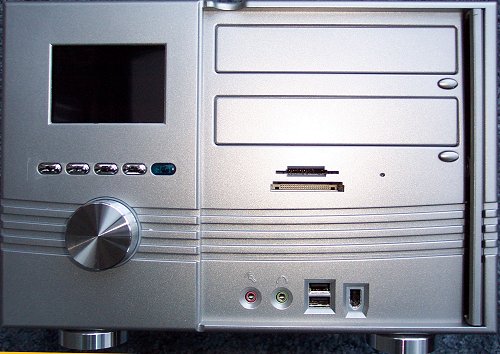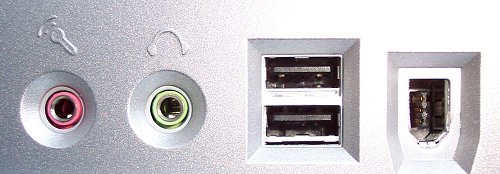Externals I
First impressions are varied. One wouldn't think it was a SFF system when taking the overall box size into account.
The ubiquitous Nokia 7210 provides a pictorial comparison. To digress a little, I'm not sure what users think of large SFF boxes. On the one hand, you'd like as much as possible. On the other, a large box often translates into a large SFF system, which is against the format's ethos in the first place. Hmmm. After successful box incursion and getting through all the extras that we'll discuss in a moment or two, the DigiDice system is exposed.

It's probably the most unique-looking SFF to hit the HEXUS labs in recent times. The usual case is to have a couple of drive bay options and connectivity ports, and scant little else. ABIT does away with that thinking by using a very hi-fi-esque setup. An LCD display obviously attracts the eye first, but the rotating control is no less daring. Rub off the name ABIT, replace it with, say, Denon, and very few would be the wiser. Perhaps that's exactly the look and image ABIT is aiming for with the DigiDice.


Quite cleverly, the door on the right rotates by 90 degrees and then slips down the extreme right-hand side. Have a look at both similar pictures and you can just see where it's moved to. Pulling it back out is a simple matter of holding it by the edge and replacing it in the original position. 2 optical drive bays, a multicard reader and the usual features' connections present themselves.
The buttons are used in conjunction with the LCD panel above. Going from left to right, they signify usage for DVD, audio, photo perusing and file copying. The IR receiver is shown on the right. We'll talk more about these when we discuss the LCD's properties.


Close-up shots of the connectivity panel shows that ABIT decided to use some of the more critical functions. Headphone and microphone sockets are to the left of 2 USB2.0 ports and a single FireWire 1394a port. There's ample room for S/PDIF or more high-speed connections, ABIT chose to keep it clean. The card reader supports the usual suspects, including Secure Digital, MultiMedia Cards, Memory Stick, Compact Flash, Microdrives, and SmartMedia cards. We think back to the Shuttle SN85G4 and its card reader. Both SFF systems sacrifice floppy drive mounting in favour of card readers. Depending upon which camp you fall in, this will be either a good or bad thing. We're ambivalent.
The plastic front to the DigiDice makes it appear rather cheap and flimsy. The plastic is thin and bends easily under modest pressure. That's especially true of the area surrounding the drive bays. The wheel's a little better but not by a great margin. The reason this point is brought up lies with comparable hi-fi units. I own a Denon DM-30 mini system. It has a brushed aluminium front with matching gold trim for buttons and the CD tray. Subjectively speaking, it's leagues and leagues ahead of the DigiDice in terms of build quality, yet it costs significantly less than £200 now. We feel that there's absolutely no reason why SFF manufacturers cannot attain the same level of quality.
Shelling out over £200 demands a better finish. It's not so much an indictment of ABIT's DigiDice as it is a general observation of companies who want to cash in on the lucrative SFF market. We have little doubt that the DigiDice is aimed towards being a hub for multimedia activities. It should look and feel the part.









